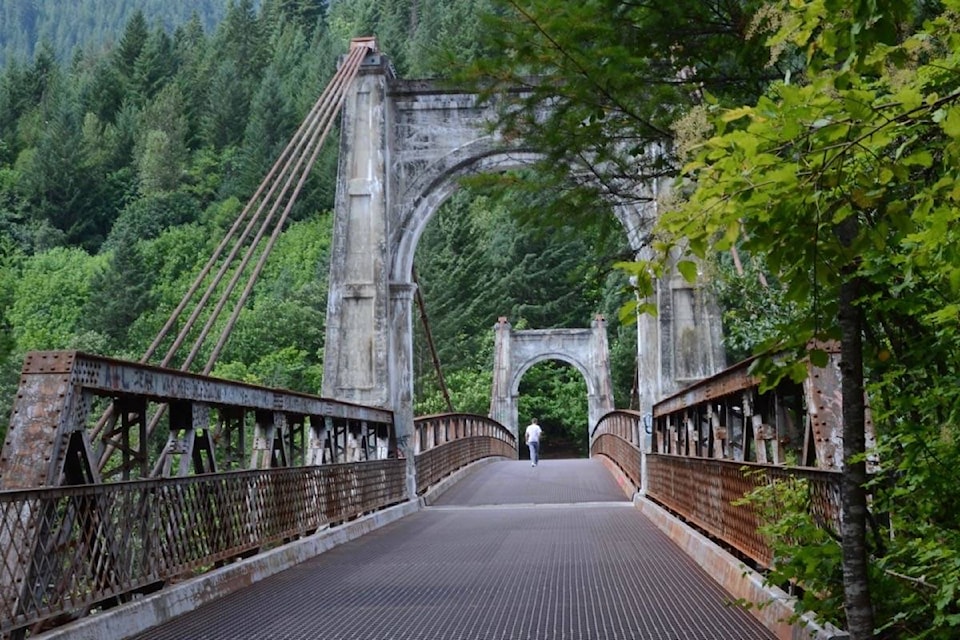The historic Alexandra Bridge has been a landmark in the Fraser Canyon since it was built in 1926, and plans to make it the centrepiece of tourism and economic development plans in the region moved forward with a site visit on July 27. The goal of the visit was to assess the condition of the bridge structure’s two support towers, and marked the start of field work for the 1926 Alexandra Bridge Rehabilitation Project’s (ABRP) 2021 season.
The ABRP is a partnership between the Spuzzum First Nation, New Pathways to Gold Society, Ministry of Transportation and Infrastructure (MOTI), BC Parks, BC Heritage Branch, and HeritageWorks.
“This initial phase of the project will determine how best to repair the concrete in the towers and other bridge elements such as railings,” says New Pathways to Gold Society (NPTGS) co-chair Terry Raymond.
“The longer-term goal is to restore this icon of B.C. transportation to a pedestrian bridge that will provide visitors with an unforgettable experience of the Fraser Canyon in the traditional territory of the Spuzzum First Nation (SFN).”
The 1926 Alexandra Bridge was built on the foundations of the original Cariboo Waggon Road bridge (constructed in 1863) near the ancient village of Kequelose, a traditional crossing point on the Fraser River. It was decommissioned in 1964 after construction of the current Alexandra Bridge, two kilometres downstream. The old bridge is now the centerpiece of Alexandra Bridge Provincial Park, created in 1984, although it sits outside the park’s boundaries.
The restoration work is being funded by the Community Economic Resiliency Infrastructure Program, which provided $500,000, and MOTI, which is contributing an additional $400,000.
READ MORE: Major grant will help refurbish historic Alexandra Bridge near Spuzzum
Don Hauka, creative/communications director of NPTGS, says that while a couple of “fairly detailed” engineering reports have been done in recent years showing the state of bridge, they’ve focused more on what’s wrong with the bridge than what’s right.
“We looked at the state of the support towers and concentrated on what’s good, what’s salvageable, what innovative solutions can we come up with. The towers are in okay shape, but it’s old concrete made from a variety of different gravels and aggregates. It’s one of those things where age and chemical combinations can make weak patches.
“The trick is to figure out whether it’s systemic across the surface. Generally speaking it’s in good shape, but the issue is what to do with those patches where there’s a bubbling and it’s not as strong as it should be. Do we look at redoing the entire face of the tower or is it a localized thing?”
Hauka says that work on the bridge is at a preliminary stage, but everyone wants to move forward on the project sooner rather than later. A rough timeline would see consultants and firms being lined up this summer, testing to develop solutions done in September/October, and a more intensive construction phase starting around March 2022: “We can’t do much November through February.”
He notes that the bridge is a centrepiece for more development in the area.
“Spuzzum First Nation has a whole economic development plan looking at the precinct around the bridge. That spot is the nexus for a huge network of trails, and there’s the Cariboo Waggon Road on both sides. SFN wants to put in a new campground and other amenities, because there aren’t a lot at the existing park.”
SFN Chief and NPTGS Director James Hobart says the rehabilitation of the 1926 Alexandra Bridge is the key to unlocking the economic potential of the Lower Canyon for his people.
“We’re developing a campsite, a convention centre, new housing, and other amenities that we hope will make the Spuzzum First Nation the Canyon’s largest employer,” he says.
“I know there’s a lot of jokes about Spuzzum and how small we are, but in a few years you won’t recognize it. It’s going to be a vibrant, happening place, and the restored 1926 Alexandra Bridge is going to be at the heart of all of it.”
The bridge restoration is also important to creating opportunities for Indigenous and non-Indigenous communities not just in the Fraser Canyon, but throughout the Hope-Barkerville “Gold Rush/Spirit Trails” corridor.
“The bridge will be a magnet to drive people there,” says Hauka. “People like it, and it’s a beautiful place. That site has been the gateway between the coast and the Interior for millennia. You’ll see people travelling on to Lytton when it’s rebuilt, to Ashcroft, if you provide a big anchor at the southern end and the Cariboo Waggon Road at the other end.”
READ MORE: Grant received for Cariboo Waggon Road restoration project north of Clinton
editorial@accjournal.ca
Like us on Facebook and follow us on Twitter
